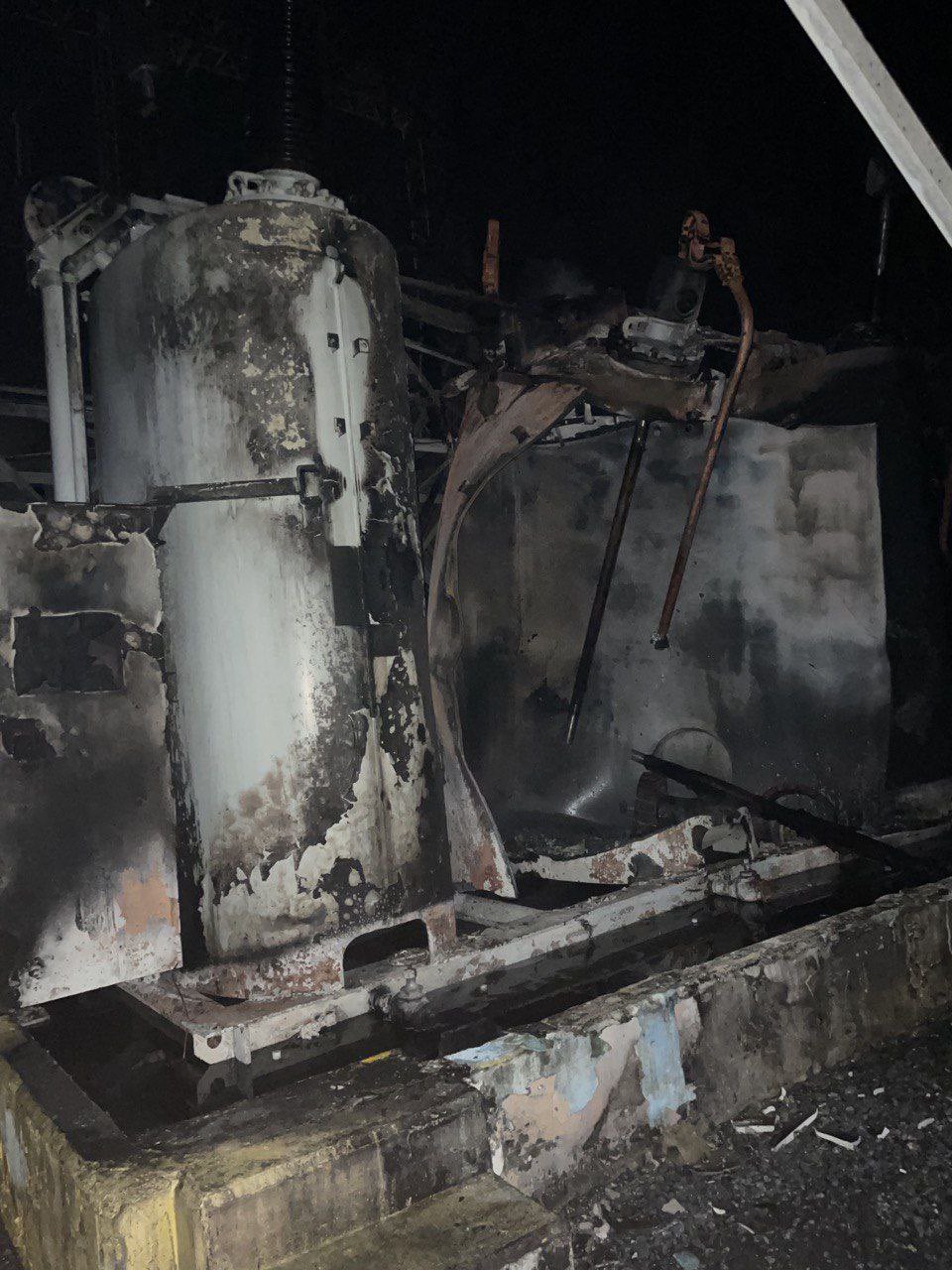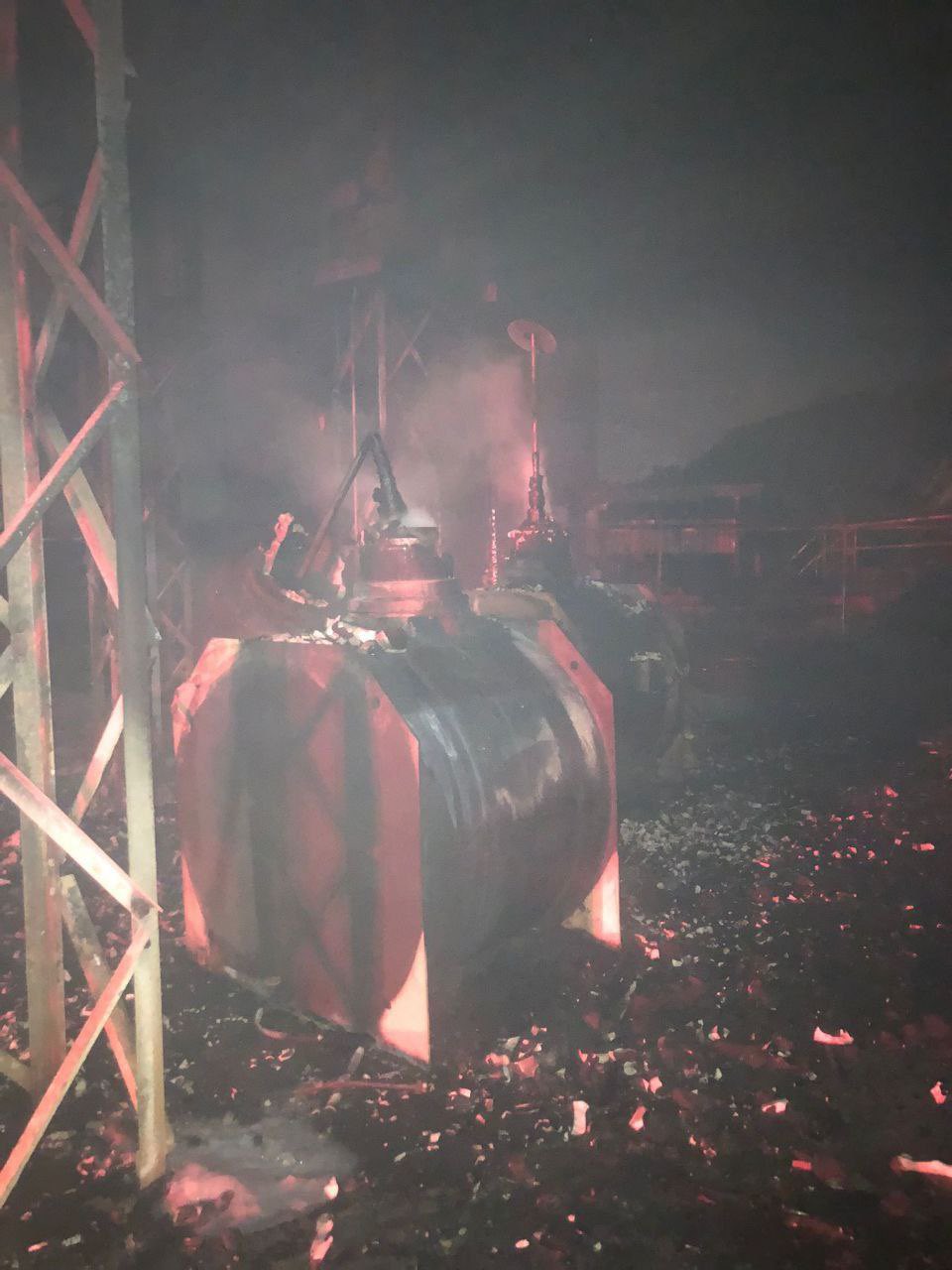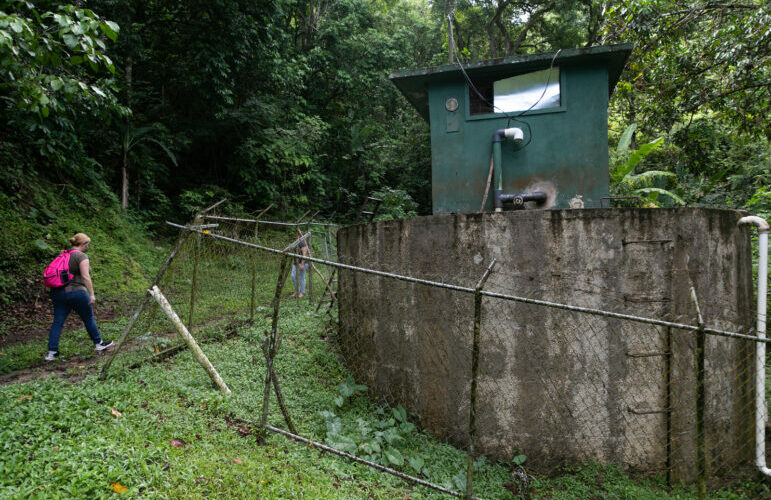Photo provided by the Puerto Rico Electric Power Authority
The process was delayed with the arrival of LUMA Energy.
The area in the switchyard where the Central Costa Sur fire occurred, which caused the general blackout last Wednesday, should have been renovated four months ago, in December 2021, according to the original infrastructure plan through which the Puerto Rico Electric Power Authority (PREPA) will access $10.7 billion in federal recovery funds.
But, after LUMA’s arrival in June 2021, as operator of the transmission and distribution system, the processes were delayed. The completion date for the repairs at the plant was postponed to February 2023, according to documents from the Puerto Rico Energy Bureau and the Federal Emergency Management Agency (FEMA), that the Center for Investigative Journalism (CPI, in Spanish) reviewed.
Avería en breaker de salida de Unidad #5 de Costa Sur al 230kv ocasionó la salida de las unidades 5 y 6 de la Central. El sistema de protección del sistema eléctrico sacó de servicio el resto de las unidades que estaban generando. pic.twitter.com/ZFAR6GocY2
— Autoridad de Energía Eléctrica (@AEEONLINE) April 7, 2022
The recovery work in Costa Sur, Guayanilla, included replacing four switches of the 230-kilowatt transmission lines because they have already completed their useful life and are obsolete. The equipment was not damaged by Hurricane Maria, but it needed to be replaced to bring the facilities up to industry standards, improve system resiliency and mitigate security risks, according to the public corporation’s 10-Year Infrastructure Plan.
The incident at the Central Costa Sur brings to question how much priority has been given to the most urgent restoration works after the hurricane that destroyed the electricity grid in 2017 and raises the need for the bureaucratic process to move faster to avoid the energy system from continuing to collapse.
As part of the infrastructure plan, in February 2021 PREPA initially submitted to FEMA the project to replace breakers in the Costa Sur area where the failure occurred last week. When the Energy Bureau found out that PREPA had submitted a plan without consulting it, it asked to stop the processes. The regulator ordered PREPA to explain in detail the recovery projects to ensure that they were aligned with the Integrated Resource Plan, the island’s energy infrastructure development roadmap.
The historic recovery process of the island’s electrical network requires meetings, permits and plans that not only depend on PREPA, but also on interventions by the Energy Bureau — which must approve each project — the Central Office of Recovery, Reconstruction and Resiliency (COR3), the Fiscal Control Board and FEMA. And the process was complicated by privatization; LUMA assumed all the procedures of the transmission and distribution system, which also brought the participation of the Public-Private Partnership Authority, which oversees the contract with the company.
From January to June 2021, the recovery plans for the electricity grid were practically stranded in the whirlwind of events surrounding PREPA: the Energy Bureau’s order to review the reconstruction criteria, the public corporation’s bankruptcy, as well as the change of its executive director. That happened mainly due to the prevailing spirit among the government entities involved, which preferred to wait for LUMA to come in, explained Tomás Torres, consumers representative before PREPA’s Governing Board.
“One of the reasons why I voted against the LUMA contract, beyond the qualifications of the company, was the timing of when that decision had been made, right amid PREPA’s bankruptcy and during the process of getting federal reconstruction funds,” said Torres. “Bringing in an entity in the midst of these processes was obviously going to delay them, regardless of who it was.”
LUMA insists it’s premature to establish what caused the failure
On June 8, 2021, when LUMA was already in the picture, the Energy Bureau approved the Costa Sur recovery project as part of a group of 65 critical initiatives. But LUMA has not yet delivered the detailed scope of work document for project 169896 at Costa Sur. It should have been delivered last February, according to what was represented to the U.S. House Committee on Natural Resources, but now it is scheduled to happen this month.



The CPI asked LUMA about the status of the Costa Sur project, why it had not submitted the detailed scope of work, why the construction date changed and if having done the replacements in 2021, as initially scheduled would have prevented the blackout. “Our entire LUMA team is fully focused on addressing the needs of our 1.5 million customers and restoring power as quickly and safely as possible. The investigation into the cause of this event is ongoing, and it would be premature and irresponsible for anyone to speculate on what caused it or could have prevented it,” the company said in a written statement.
FEMA hasn’t really approved the power grid reconstruction projects
The reconstruction work in Costa Sur is part of a group of projects that, nearly five years after the hurricane, are just getting started.
Although LUMA’s Vice President of Engineering Shay Bahramirad said during a news conference that FEMA had “approved” 180 projects for rebuilding the power grid, the reality is that those projects are still in the formulation process. That is, they have been presented but have not gotten final approval, according to FEMA.
An example of the lag is that, since 2020, the facilities in Aguirre, Costa Sur, Culebra and Vieques have eight projects on the list of the 180 permanent work initiatives formulated by PREPA and LUMA. This means that the money to develop them has not been obligated.
When the CPI inquired, PREPA said it would need until Monday of this week to explain why it took so long for the formulation process of the eight projects they presented in 2020 to be completed.
The path is long to reach the funds obligation for the power grid. Each project that PREPA and LUMA submit to FEMA is assigned a number as part of the formulation process, which consists of five stages. The first is design and engineering work. Eventually, the detailed scopes of work are presented. The most important thing is that all local and federal environmental and historic conservation laws and regulations are complied with, costs are estimated and hazard mitigation proposals are specified.
PREPA and LUMA must develop a clear and complete description of each project. FEMA calls this process a “scope of work” definition process. Once the federal agency evaluates it and its authorization, the final amount is approved. That is, in FEMA’s jargon, “the money is obligated.”
In the March progress report before the Energy Bureau, PREPA and LUMA established that only 19 “scopes of work” have been submitted to FEMA: the eight from PREPA and 11 from LUMA. This constitutes barely 10% of the total of this group of formulated projects.
Of PREPA’s $9.4 billion allocation for permanent work, the FEMA website indicates that nearly $438 million have been approved for architectural and engineering design work alone. Of this last amount, only $7 million have been disbursed, according to COR3.
This multi-million-dollar budget was allocated under a different initiative than FEMA usually uses to allocate funds, known as the FEMA Accelerated Obligation Strategy (FAASt). Typically, each damaged site is inspected and costs estimated. But several FEMA and COR3 officials assured the CPI that the damage was similar in each of the affected localities. Therefore, not all PREPA sites with damage after Hurricane María were inspected in detail. PREPA was awarded a fixed global budget based on a sampling of certain facilities. The federal and Puerto Rican governments agreed that doing it project by project would take too much time, effort, and money.
RECOVERY FUNDS ALLOCATED TO PREPA
The total funds allocated by FEMA to PREPA is $11.7 billion for Hurricanes Irma and María, the 2020 earthquake, and the pandemic.
Public Assistance
● $9.4 billion available for permanent works
○ $437.7 million obligated for architectural and engineering design work
○ $7 million disbursed
2020 Earthquakes
● $480,531 obligated for permanent works
● $0 disbursed
Hazard Mitigation Grant Program (HMGP)
● $1.5 billion available for four projects
○ $34.4 million obligated
CDBG-DR
● $1.9 billion allocated
● $0 obligated
Sources: COR3, FEMA and the US Department of Housing and Urban Development.
Vanessa Colón Almenas is a corps member of Report for America.

8 septiembre, 2022 LEER MAS